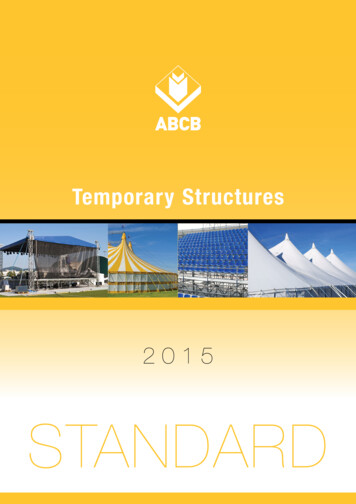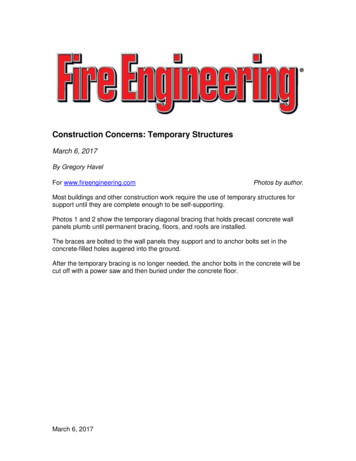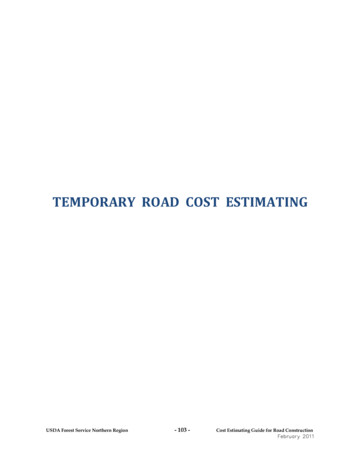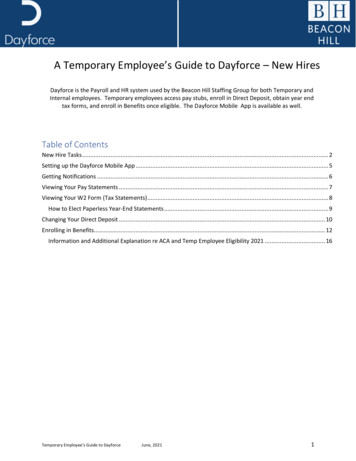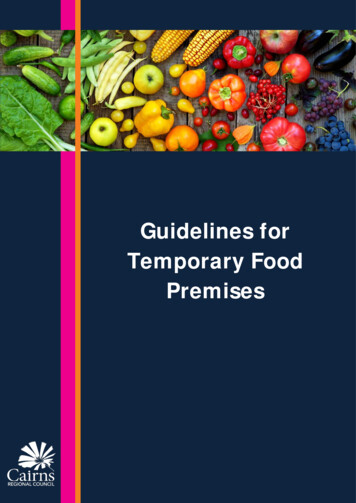
Transcription
Traffic Control Devices ManualPart 8Code of practice for temporarytraffic management (CoPTTM)manual number: SP/M/010Section C NZ Transport Agencywww.nzta.govt.nzFourth edition, Amendment 5 ofCode of practice for temporary traffic managementDate of issue: November 2018Effective date: 1 February 2019ISBN 978-0-478-40772-3 (print)ISBN 978-0-478-40773-0 (online)
Copyright informationThis publication is copyright NZ Transport Agency.Material in it may be reproduced for personal or in-houseuse without formal permission or charge, provided suitableacknowledgement is made to this publication and the NZTransport Agency (NZTA) as the source. Requests andenquiries about the reproduction of material in thispublication for any other purpose should be made to:NZ Transport AgencyPrivate Bag 6995Wellington 6141The permission to reproduce material in this publicationdoes not extend to any material for which the copyright isidentified as being held by a third party. Authorisation toreproduce material belonging to a third party must beobtained from the copyright holder(s) concerned.DisclaimerThe NZTA has endeavoured to ensure material in thisdocument is technically accurate and reflects legalrequirements. However, the document does not overridegoverning legislation. The NZTA and its employees andagents involved in the preparation and publication of thisdocument do not accept liability for any consequencesarising from the use of this document. Users of thisdocument should apply and rely upon their own skill andjudgment, and should not rely on the manual's contents inisolation from other sources of advice and information. Inapplying their own skill and judgment, the standards ofsafety and serviceability explicitly required or implied bythis manual shall not be reduced. If the user is unsurewhether the material is correct, they should make directreference to the relevant legislation or regulations andcontact the NZTA.More informationPublished 2013ISBN 978-0-478-40772-3 (print)ISBN 978-0-478-40773-0 (online)
NZ Transport AgencySection C – Static operationsC1 General1C2 Worksite layout2C2.1 Introduction2C2.2 Explanation of dimensions in worksite layout distances tables3C2.3 Level LV worksite layout distances4C2.4 Level 1 worksite layout distances5C2.5 Combined level LV and level 1 worksite layout distances6C2.6 Level 2 worksite layout distances7C2.7 Level 3 worksite layout distances8C2.8 Lane widths9C3 Signs and worksite zones10C3.1 Introduction10C3.2 Worksite zones10C3.3 Position of signs13C3.4 Sign height15C3.5 Quality of signs, stands and/or supports16C3.6 Covering permanent signs17C4 Temporary speed limit (TSL)18C4.1 Introduction18C4.2 Requirements19C4.3 Location of TSLs21C4.4 General requirements for TSLs23C5 Delineation devices25C5.1 Introduction25C5.2 Use and placement of delineation devices25C5.3 Quality of delineation devices26C6 Safety zones27C6.1 Introduction27C6.2 Safety zone requirements28Traffic control devices manual part 8 CoPTTMSection C – Page i4th edition, November 2018
NZ Transport AgencyC7 Tapers29C7.1 Introduction29C7.2 Types of taper29C7.3 Taper visibility and length30C8 Shoulder and lane closures32C8.1 Shoulder and roadside activities32C8.2 Lane closures/shifts34C9 Road closures and detours42C9.1 Introduction42C9.2 Road closures42C9.3 Detours45C10 Positive traffic management48C10.1 Introduction48C10.2 Stop/go operations (manual traffic control)49C10.3 Portable traffic signals56C10.4 Pace vehicles (pilot) method60C10.5 Temporary speed humps61C11 Temporary traffic management (TTM) installation, managementand removal62C11.1 Introduction62C11.2 Set-up and removal of worksite63C11.3 Monitoring of the worksite66C12 Unattended worksites and activity at night67C12.1 Introduction67C12.2 Unattended worksites67C12.3 Excavations67C12.4 Activity at night69C13 Pedestrians and cyclists71C13.1 Introduction71C13.2 Pedestrian requirements71C13.3 Cyclist requirements76Traffic control devices manual part 8 CoPTTMSection C – Page ii4th edition, November 2018
NZ Transport AgencyC14 Work vehicles, equipment and materials77C14.1 Use of vehicles77C14.2 Other requirements78C15 Worksite access79C15.1 Introduction79C15.2 Access points79C16 Managing traffic queues81C16.1 Introduction81C16.2 Queuing and delays81C17 Light arrow system (LAS), horizontal arrow board, truck-mountedattenuator (TMA) and variable message sign (VMS)84C18 Temporary road safety barrier systems87C18.1 Introduction87C18.2 Barrier hardware selection considerations88C18.3 Lateral placement90C18.4 End treatments92C18.5 Barrier length94C18.6 Ground shape96C18.7 Delineation97C18.8 Visibility screens98C18.9 Approval requirements99C18.10 Design, installation and inspection of temporary barriersystems99C19 Maintenance standards100C19.1 General100C19.2 Quality classifications and requirements100C19.3 Evaluation for classification of TTM devices101C19.4 Personal safety107C19.5 Monitoring of traffic management measures108Traffic control devices manual part 8 CoPTTMSection C – Page iii4th edition, November 2018
NZ Transport AgencyC1 GeneralC1 GeneralC1.1.1 DefinitionStatic operations are activities contained within a fixed worksite.Activities within a moving worksite are subject to the rules and guidelines insection D Mobile operations.C1.1.2 ClosurelengthThe length of any closure must be the minimum required to undertake theactivity.Closures should generally not be longer than 1km.C1.1.3 Number ofcontractors at aworksiteA worksite must be under the control of only one contractor at a time.If another contractor wishes to undertake activity on the same section ofroad they must request permission from the current worksite contractor,the engineer and/or the traffic management coordinator (TMC), or otherroad controlling authority (RCA) authorised person.The TMC/engineer, or any other RCA-authorised person, must approve anyamendment to the existing traffic management plan (TMP) if it has to beadjusted to accommodate another contractor's activity.C1.1.4 Inclementweather conditionsWhen adverse weather conditions affect visibility to the signs and/or theworksite so that sign visibility distance to the first sign cannot be achieved,it may be necessary to cease the activity and clear the worksite of allpersonnel in the interests of safety.In exceptional cases it may also be necessary to clear the carriageway of allobstructions caused by the works, if this can be done safely. A decision onthe need to clear the carriageway should be based on consideration of allprevailing circumstances, including:the nature of the works traffic volumes, and weather conditions. Traffic control devices manual part 8 CoPTTMSection C – Page 14th edition, November 2018
NZ Transport AgencyC2 Worksite layoutC2 Worksite layoutC2.1 IntroductionC2.1.1 GeneralFor level low volume (LV) and level 1 roads the worksite measurements(except lane width) are based on the permanent speed limit or RCAdesignated operating speed. Refer to section C2.8 Lane widths.For levels 2 and 3 temporary traffic management (TTM) the approach signdistances and spacings, the initial taper(s) and any longitudinal safety zoneassociated with that taper must be based on the permanent speed limit.The layout distances of the remainder of the worksite, including anysubsequent tapers, may be based on the TSL, provided the TSL is appliedprior to the first taper.C2.1.2 Signvisibility distance(A)The uninterrupted sight distance from an approaching road user to the firstadvance warning sign is defined as the sign visibility distance, A. The higherthe permanent speed limit, the greater the sign visibility distance required.Sign visibility distances are given in the layout distance tables for levels LV,1, 2 and 3.C2.1.3 Warningdistance (B)The distance between the first advance warning sign and the start of thetaper, or the start of the longitudinal safety zone if no taper is required(refer to subsection C6.2.2 Longitudinal (lead in) safety zones), is definedas the warning distance, B.The warning distance is normally achieved by locating signs at theappropriate sign spacing. Where this cannot be achieved the sign spacingdistances will need to be increased.The warning distance has only been shown on drawings where thecumulative sum of sign spacing distances on an approach to a closure isless than, or equal to, the minimum warning distance required.Warning distances are given in the layout distance tables for levels LV, level1 and level 2.C2.1.4 Sign spacingdistance (C)The sign spacing distance, C, is defined as the distance between two signs.Temporary warning and regulatory speed signs are required to be located atsign spacing distances to allow the road user to read, understand andcomply with the sign’s message.Signs that have a supplementary plate displaying a distance to a taper mustbe placed that specific distance in advance of the start of the taper or inadvance of the longitudinal safety zone when no taper is required. Ifrequired, extend sign spacing to achieve minimum warning distance.Where the cumulative sum of sign spacing distances on an approach to aworksite is less than the minimum warning distance required, the signspacing will need to be increased such that the warning distance is achieved.Sign spacing distances are given in the layout distance tables for levels LV,1, 2 and 3.Traffic control devices manual part 8 CoPTTMSection C – Page 24th edition, November 2018
NZ Transport AgencyC2 Worksite layoutC2.2 Explanation of dimensions in worksite layout distances tablesDimensionsRefer toASign visibilitydistanceC2 Worksite layoutBWarningdistanceC2 Worksite layoutCSign spacingC2 Worksite layoutDLongitudinalsafety zoneC6.2.2 Longitudinal (leadin) safety zonesNote: Apart fromapproved TTM equipment,this space must bemaintained as acompletely clear zone.ELateral safetyzoneC6.2.3 Lateral safety zonesFLane widthC2 Worksite layoutGTaper lengthNote: Apart fromapproved TTM equipment,this space must bemaintained as acompletely clear zone.Note: Apart fromapproved TTM equipment,this space must bemaintained as acompletely clear zone.Working space – The area set aside for work.Closure – The area of carriageway which road users are excludedfrom (eg the taper, longitudinal and lateral safety zones and any endtaper).Traffic control devices manual part 8 CoPTTMSection C – Page 34th edition, November 2018
NZ Transport AgencyC2 Worksite layoutC2.3 Level LV worksite layout distancesPermanent speed limit or RCAdesignated operating speed (km/h) 50607080901005060708090100B Warning distance (m)50 or 30*80105120135150C Sign spacing (m)25 or 15*4050607075000000111111Traffic signsA Sign visibility distance (m)Safety zonesD Longitudinal (m)E Lateral (m) Lateral behind barrier installationAs specified by the Installation DesignerTapersG Taper length (m)#253035404550Cone spacing in taper (m)2.52.55555Cone spacing: working space (m)101020202020Delineation devices* Larger minimum distances apply on all state highways. The smaller minimum distances may beapplied on other roads to accommodate road environment constraints. On LV roads, the lateral safety zone may be reduced or eliminated in order to retain a single lanewidth. Positive traffic management and an appropriate TSL must be used.#1. On non-state highways with permanent speeds 50km/h or less, a 10m taper (with cones at 1mcentres) may be used when there are road environment constraints (eg intersections andcommercial accesses).2. On all roads where the shoulder width is less than 2.5m and the activity does not affect the livelane, a 10m shoulder taper is permitted (with at least 5 cones at no greater than 2.5m centres).3. A taper of 30m (with cones at 2.5m centres) must be used where manual traffic control(stop/go), portable traffic signals or priority give way are employed.Lane widths (based on permanent speed or TSL if applied)Speed (km/h)FLane width cept for delineation device spacings, which are maximum values, the distances specified in theabove tables are minimum values.LV/low-risk roads (less than 250vpd - less than 20 vehicles per hour)When on the shoulder: If CSD not available: Advance warning sign and base to be installed with sign visibility distanceand warning distance in place If CSD available: Advance warning sign may be attached to the rear of a work vehicle which has anamber flashing beacon(s) and is visible to approaching road users from the rear.When the activity encroaches onto a live lane consider alternating flow controls.If the above requirements cannot be achieved, the operation must be modified to comply with theappropriate level LV or level 1 requirements.Traffic control devices manual part 8 CoPTTMSection C – Page 44th edition, November 2018
NZ Transport AgencyC2 Worksite layoutC2.4 Level 1 worksite layout distancesPermanent speed limit or RCAdesignated operating speed (km/h) 50607080901005060708090100B Warning distance (m)50 or 30*80105120135150C Sign spacing (m)25 or 15*405060707510 or 5*1530455560111111Traffic signsA Sign visibility distance (m)Safety zonesD Longitudinal (m)ELateral (m)Lateral behind barrier installationAs specified by the Installation DesignerTapersG Taper length (m)#3050708090100K Distance between tapers (m)40507080901002.52.555555510101010Delineation devicesCone spacing in taper (m)Cone spacing: Working space (m)* Larger minimum distances apply on all state highways and also on all multi-lane roads. The smallerminimum distances may be applied on other roads to accommodate road environment constraints.#1. On non-state highways with speeds 50km/h or less, a 10m taper (with cones at 1m centres)may be used when there are road environment constraints (eg intersections and commercialaccesses).2. On all roads where the shoulder width is less than 2.5m and the activity does not affect the livelane, a 10m shoulder taper is permitted (with at least 5 cones at no greater than 2.5m centres).3. A taper of 30m (with cones at 2.5m centres) must be used where manual traffic control(stop/go), portable traffic signals or priority give way are employed.Lane widths (based on permanent speed or TSL if applied)Speed (km/h)FLane width cept for delineation device spacings, which are maximum values, the distances specified in theabove tables are minimum values.Traffic control devices manual part 8 CoPTTMSection C – Page 54th edition, November 2018
NZ Transport AgencyC2 Worksite layoutC2.5 Combined level LV and level 1 worksite layout distancesPermanent speed limit or RCA60708090100 50designated operating speed (km/h)Traffic signsA Sign visibility distance (m)5060708090100B Warning distance (m)50 or 30*80105120135150C Sign spacing (m)25 or 15*4050607075Safety zonesD Longitudinal (m) 10 or 5*1530455560E Lateral (m) 111111Lateral behind barrier installationAs specified by the Installation DesignerTapersG Taper length (m)#3050708090100G LV roads taper length (m)#253035404550K Distance between tapers (m)4050708090100Delineation devicesCone spacing in taper (m)2.52.55555Cone spacing: Working space (m)##5510101010* Larger minimum distances apply on all state highways and also on all multi-lane roads. The smallerminimum distances may be applied on other roads to accommodate road environment constraints. On LV roads the longitudinal and lateral safety zones may be reduced, or eliminated, in order toretain a single lane width. Positive traffic management and an appropriate TSL must be used.# 1. On non-state highways with speeds 50km/h or less, a 10m taper (with cones at 1m centres)may be used when there are road environment constraints (eg intersections and commercialaccesses).2. On all roads where the shoulder width is less than 2.5m and the activity does not affect the livelane, a 10m shoulder taper is permitted (with at least 5 cones at no greater than 2.5m centres).3. A taper of 30m (with cones at 2.5m centres) must be used where manual traffic control(stop/go), portable traffic signals or priority give way are employed.##LV roads: double the cone spacing alongside working space (eg 5 10, 10 20).Lane widths (based on permanent speed or TSL if applied)Speed (km/h)FLane width cept for delineation device spacings, which are maximum values, the distances specified in theabove tables are minimum values.LV/low-risk roads (less than 250vpd - less than 20 vehicles per hour)When on the shoulder: If CSD not available: Advance warning sign and base to be installed with sign visibility distanceand warning distance in place If CSD available: Advance warning sign may be attached to the rear of a work vehicle which has anamber flashing beacon(s) and is visible to approaching road users from the rear.When the activity encroaches onto a live lane consider alternating flow controls.If the above requirements cannot be achieved, the operation must be modified to comply with theappropriate level LV or level 1 requirements.Traffic control devices manual part 8 CoPTTMSection C – Page 64th edition, November 2018
NZ Transport AgencyC2 Worksite layoutC2.6 Level 2 worksite layout distancesPermanent/TSL (km/h) 5060708090100 /11060/50 70/60 80100120120 140160200200Traffic signsA Sign visibility distance (m)B Warning distance (m)100/75120/90C Sign spacing (m)50/35 60/45 7080100100152030456060111111Safety zonesD Longitudinal (m)*ELateral (m)1. Behind cones2. Behind barrier installationsAs specified by the Installation DesignerTapersH Initial taper length per lane (m)**I90/50 100/60 .52.52.55510101010Subsequent taper length per lane (m)K Minimum distance between tapers (m)Spacing (centres)Delineation device*All tapers (m)Cones parallel to the lane - eg betweentapers and alongside working space (m)At merge and diverge points for ramps2.5m for 10m eitherand slip lanes, intersecting road entry and side of a change inexit points, and worksite access pointsalignment2.5m for 20m either side of achange in alignmentA longitudinal safety zone is not required when a barrier completely protects the approach endof the worksite.** Taper length is based on a single lane shift of 3.5m. The longer distance is the desirable distance, the shorter distance is the minimum distancerequired. The longer distances must be used wherever possible. The shorter distances may onlybe used where there are road environment constraints.Lane widths (based on permanent speed or TSL if applied)Speed (km/h)FLane width .5Except for delineation device spacings, which are maximum values, the distances specified in theabove tables are minimum values.Approach sign distances and spacings, the initial taper(s) and any longitudinal safety zone associatedwith that taper must be based on the permanent speed limit. The layout distances of the remainder ofthe worksite, including any subsequent tapers, may be based on the TSL, provided the TSL is appliedprior to the first taper.Traffic control devices manual part 8 CoPTTMSection C – Page 74th edition, November 2018
NZ Transport AgencyC2 Worksite layoutC2.7 Level 3 worksite layout distancesPermanent/TSL (km/h) 5060708090100/11060/50 70/60 60111111Traffic signsA Sign visibility distance (m)C Sign spacing (m) - Desirable Sign spacing (m) - MinimumSafety zonesD Longitudinal (m)*E Lateral (m)1. Behind cones etc2. Behind barrier installationsAs specified by the Installation DesignerTapers90/50 100/60 H Initial taper length per lane (m)**120150180180ISubsequent taper length per lane (m)50607080100100KMinimum distance between tapers(m) eation devices (all speeds)Spacing (centres)All tapers (m)Cones parallel to the lane (egbetween tapers and alongside theworking space) (m)At merge and diverge points forramps and slip lanes, intersectingroad entry and exit points, andworksite access points2.5m for 10meither side of achange inalignment2.5m for 20m either side of achange in alignment The longer distance is the desirable distance, the shorter distance is the minimum distanceallowed. The desirable distances must be used wherever possible. The minimum distances mayonly be used where there are road environment constraints.Where only one sign is erected in advance of a taper the distance from the sign to the taper is2xC.*A longitudinal safety zone is not required when a barrier completely protects the approach endof the worksite. Refer subsections H1.17 and H1.18.**Taper length is based on a single lane shift of 3.5m.*** Must be altered if required to meet the distance shown on the TLS supplementary plate.Lane widths (based on permanent speed or TSL if applied)Speed (km/h)FLane width .5Except for delineation device spacings, which are maximum values, the distances specified in theabove table are minimum values. Approach sign distances and spacings, the initial taper(s) and anylongitudinal safety zone associated with that taper must be based on the permanent speed limit. Thelayout distances of the remainder of the worksite, including any subsequent tapers, may be based onthe TSL, provided the TSL is applied prior to the first taper.Traffic control devices manual part 8 CoPTTMSection C – Page 84th edition, November 2018
NZ Transport AgencyC2 Worksite layoutC2.8 Lane widthsThe temporary lane width is a function of the speed limit applied ata worksite.The temporary lane widths for TTM are:Permanent/TSL(km/h)FLane width 53.5Temporary lane widths are measured as the available clear distancebetween delineation devices.Temporary lane widths must not exceed 4m.If the activity does not affect the traffic lane this table does not need to beapplied.C2.8.1 HeavyvehiclesWorksites with a high proportion of heavy vehicles may require lane widthsgreater than the values given in the table above.Traffic control devices manual part 8 CoPTTMSection C – Page 94th edition, November 2018
NZ Transport AgencyC3 Signs and worksite zonesC3 Signs and worksite zonesC3.1 IntroductionC3.1.1 GeneralAll TTM signs must meet the design requirements in section B1 Signs.C3.2 Worksite zonesC3.2.1 Threeworksite zonesA standard worksite is divided into three distinct, but interrelated, zones.These are:advance warning direction and protection, and end of works. C3.2.2 Signs inworksite zonesTTM signs provide the road user with information on:AdvancewarningThe presence ofthe worksiteand the type ofhazard.Direction The route theyandare required toprotection travel tonegotiate theworksite safely.The areas of theroad which mayand may not beused.The start andend of the TSLfor the worksite.End ofworksTraffic control devices manual part 8 CoPTTMThe end of thehazard createdby the worksiteand the returnof normal roadoperatingconditions.Section C – Page 104th edition, November 2018
NZ Transport AgencyC3.2.3 Advancewarning zone signsC3 Signs and worksite zonesAdvance warning signs alert road users to a hazard or activity on, or near,the road.The signs indicate the nature of the hazard or activity. The signs must beplaced at specific distances from the hazard to give road users sufficienttime to slow down or to change their direction of travel.Advance warning signs are required where the normal operating conditionsof the road are changed due to the nature of the activity. Advance warningsigns are required for traffic travelling in all directions for all activities on thecarriageway, shoulder and footpath.When the activity and associated safety zones are outside the edgeline andnot on a sealed shoulder or footpath, advance warning signs are required inonly one direction. For example, a power line maintenance activity outsidethe edgeline on a grass shoulder only requires advance warning signs in thedirection of travel affected.For level LV, level 1 and level 2 roads a reduced level of advance warning isacceptable. Refer subsections C8.1.2 Shoulder closures and roadsideactivities.Advance warning signs, and their requirement for use, are described insubsection B1.4.1 Advance warning.C3.2.4 Directionand protectionzone - signsThe direction and protection signs advise road users that the normal trafficlanes are not available and that they are required to change lanes, or thatmanual traffic controllers (MTC) or portable traffic signals are operating.A limited number of regulatory signs may also be used.Direction and protection signs, and their requirement for use, are describedin subsection B1.4.2 Direction and protection.Traffic control devices manual part 8 CoPTTMSection C – Page 114th edition, November 2018
NZ Transport AgencyC3.2.5 End ofworks zone - signsC3 Signs and worksite zonesEnd of works signs advise road users that the worksite or temporary hazardhas been passed. The signs further advise that the condition of the road andthe speed limit are returned to normal operating conditions.The end of works signs are placed as follows:If a TSL has been in place the speed limit must bereinstated to the permanent speed limit.Road users are also provided with any advisoryinformation connected with the worksite.If the advance warning is provided by a T1 type roadworks sign then the end of works sign is the TG2WORKS END sign.On two-way two-lane roads the TG2 WORKS ENDsign is erected on its own stand opposite the firstadvance warning sign for a road works worksite.The TG2 WORKS END sign must be displayed on theleft-hand side.Where the first advance warning sign is installed onboth sides of the road, the TG2 WORKS END signmay be placed on the back of each advance warningsign.A TG31 THANK YOU sign may be erectedimmediately below the TG2 sign, when the additionalmessage is considered desirable. The Land TransportRule: Traffic Control Devices 2004 (TCD rule), part3, schedule 1, number W7-7.1 allows a combinedTG2/TG31 plate. This may be used in the dimensionsgiven in the rule.If the advance warning is anything other than aT1A/B then the end of works sign is the TG31 THANKYOU sign.The TG31 THANK YOU sign is erected on its ownstand opposite the first advance warning sign for theworksite.If advance warning signs are located on both sides ofthe road a TG31 THANK YOU sign may be attachedto the back of each sign.End of works signs, and their use, is described in subsection B1.4.3 End ofworks.Traffic control devices manual part 8 CoPTTMSection C – Page 124th edition, November 2018
NZ Transport AgencyC3 Signs and worksite zonesC3.3 Position of signsC3.3.1 Location oftemporary warningand TSL signsOn all roads temporary warning and regulatory signs are required to belocated on the left-hand side of the road for the direction of travel. On level1, level 2 and level 3 multi-lane roads additional temporary warning andspeed limit signs must be located on the right-hand side of the road. At allchanges of speed, TSL signs must be gated (a TSL sign on each side of theroad), except for roads with an annual average daily traffic (AADT) of lessthan 500vpd.On two-way two-lane roads repeater TSLs are required at no more than400m intervals on the left-hand side for each direction of travel.On multi-lane roads, all repeater signs must be gated to ensure thatvehicles in the offside lane can see a TSL sign.C3.3.2 Positioningof signsSigns must be located in a manner such that the safety of road users,including pedestrians and cyclists, is not affected.Signs must not be placed in a marked cycle lane or on a footpath unless it issafe to have them there (eg minimum width is maintained). A delineationdevice, such as a cone, must be placed next to a sign erected in a cycle laneor on a footpath so that the extent of encroachment of the sign base intothe cycle lane or footpath is clearly delineated.All traffic signs must be positioned to ensure they are:upright 0.5m clear of the travelled path, wherever possible, on level LV andlevel 1 roads 1.25m clear of the travelled path wherever possible, on level 2 andlevel 3 roads not obscured by parked vehicles, trees or other obstructions. In a lessthan 65km/h area, a 10m clear space must be provided as shown in thediagram below 10 metre (approx 2 car parks)PN11PN116mmaxFootpath30Parking LaneTraffic LaneTraffic control devices manual part 8 CoPTTMSection C – Page 134th edition, November 2018
NZ Transport AgencyC3 Signs and worksite zones not encroaching on a marked cycle lane unless safe to do sonot encroaching on a footpath unless:– adequate footpath width remains as per section C13 Pedestrians andcyclists– any protruding edges of the sign and base are delineated by cones toaid sight-impaired pedestriansnot a hazard to road workers or road users, including cyclists andpedestriansnot obscuring view of other signs, devices or other traffic on the roadnot directing traffic into incorrect or dangerous situationskept clean in accordance with maintenance standards especially in dustyor muddy conditionsremoved or covered when the activity ceases, andsign bases must not be left in place, without signs attached, in a mannerthat will be a hazard to any road user, including pedestrians and cyclists.All signs must be mounted on stands except as below: in the case of road closures, signs may be mounted on abarricade/barrier In the case of level LV/LR activities, advance warning signs may bemounted on a stationary vehicle with an amber flashing beacon if clearsight distance is available.At least one delineation device must be placed at the base of each signstand on the side closest to traffic: on levels 2 and 3 at all times on levels LV and 1 at night on any other roads when required by the RCA/TMC unless more are specified on the TMP.Where worksite restrictions such as local topography, median barriers, orbridges preclude the placing of the required signs either: the signs must
C11 Temporary traffic management (TTM) installation, management and removal 62 C11.1 Introduction 62 C11.2 Set-up and removal of worksite 63 C11.3 Monitoring of the worksite 66 C12 Unattended worksites and activity at night 67 C12.1 Introduction 67 C12.2 Unattended worksites 67 C12.3 Excavations 67 C12.4 Activity at night 69







